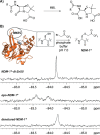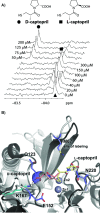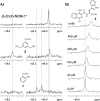Monitoring conformational changes in the NDM-1 metallo-β-lactamase by 19F NMR spectroscopy
- PMID: 24615874
- PMCID: PMC4499255
- DOI: 10.1002/anie.201310866
Monitoring conformational changes in the NDM-1 metallo-β-lactamase by 19F NMR spectroscopy
Abstract
The New Delhi metallo-β-lactamase (NDM-1) is involved in the emerging antibiotic resistance problem. Development of metallo-β-lactamases (MBLs) inhibitors has proven challenging, due to their conformational flexibility. Here we report site-selective labeling of NDM-1 with 1,1,1-trifluoro-3-bromo acetone (BFA), and its use to study binding events and conformational changes upon ligand-metal binding using (19) F NMR spectroscopy. The results demonstrate different modes of binding of known NDM-1 inhibitors, including L- and D-captopril by monitoring the changing chemical environment of the active-site loop of NDM-1. The method described will be applicable to other MBLs and more generally to monitoring ligand-induced conformational changes.
Keywords: 19F-NMR; NDM-1; antibiotic resistance; captopril; metallo-β-lactamases.
© 2014 WILEY-VCH Verlag GmbH & Co. KGaA, Weinheim.
Figures



References
Publication types
MeSH terms
Substances
Grants and funding
LinkOut - more resources
Full Text Sources
Other Literature Sources

